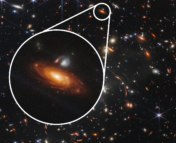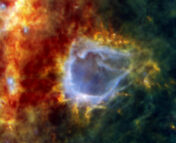Title: Insights from HST into ultramassive galaxies and early-universe cosmology
Authors: Nashwan Sabti, Julian B. Muñoz, and Marc Kamionkowski
First Author’s Institution: William H. Miller III Department of Physics and Astronomy, John Hopkins University, Maryland, U.S.A.
Status: Accepted for publication in Physical Review Letters [closed access]
This bite was written and published as part of Astrobites’s new partnership with the American Physical Society (APS). As part of this partnership, we cover selected articles from the Physical Review Journals, APS’s premier publications covering all aspects of physics. For more coverage as part of this partnership, see our other PRJ posts.
Recent observations from the James Webb Space Telescope (JWST) have thrown a curveball at our standard cosmological model, the Lambda-Cold Dark Matter (ΛCDM). JWST reports the existence of early massive galaxies with stellar masses way larger than what ΛCDM predicts. This has raised questions about the reliability of the existing cosmological model, prompting efforts to tweak ΛCDM to match the new findings. Today’s paper challenges these modifications by showcasing how they are at odds with the established ultraviolet (UV) galaxy luminosity function derived from the Hubble Space Telescope (HST) data. The authors suggest that a cosmological explanation for the excess of masses observed by JWST might not be the ideal solution.
The ΛCDM
The ΛCDM model operates assuming that the universe began with the Big Bang. It relies on two main theoretical frameworks: the standard model of particle physics, which explains the behavior of tiny particles through quantum mechanics, and the general theory of relativity, which explains the physics of the very large structures by taking into account the cosmological constant (Λ) that is linked to dark energy. The ΛCDM provides the theoretical basis for understanding various observed features of the universe, such as the cosmic microwave background (CMB), the large-scale structure in the distribution of galaxies, and the observed abundances of hydrogen, helium, and lithium.
According to ΛCDM, the first structures to form in the cold dark matter (CDM) scenario are typically the smallest ones. Larger structures then develop from the smaller ones in a process called hierarchical clustering or bottom-up mass assembling. As the universe cooled after the Big Bang, slight changes in density led to the condensation of dark matter and the formation of gas molecules within it. Over time, these structures merged to form larger galaxies, with massive galaxies such as the Milky Way possibly consuming many small dwarf galaxies over time. This scenario effectively explains the observed large-scale structure of the universe and accurately predicts the masses of galaxies.

JWST and HST Data
The HST, operational in the UV and optical regimes for over three decades, has been a cornerstone in advancing our comprehension of the early Universe astrophysics. Through its deep field surveys, HST has significantly enriched our understanding of the properties and distribution of galaxies in the early Universe. These observations have also contributed essential data for constructing the galaxy luminosity functions based on the observed rest-frame UV light. This aspect is particularly intriguing as UV light serves as a probe for star formation processes, given that young massive stars predominantly emit in the UV spectrum.
On the other hand, the JWST, equipped with longer-wavelength capabilities (operating in the infrared regime), has extended our observational capabilities further. By measuring the rest-frame visible light of objects with high redshifts, such as those at cosmological redshifts around 7, the JWST enables us to peer back in time to when the universe was only 1.5 billion years old. Recent JWST observations have unveiled the existence of ultra-massive galaxies within the redshift range of 7 to 10, with stellar masses that surpass the expectations set by the ΛCDM model.
This discovery has spurred theoretical work to revise the existing models of galaxy formation and early-universe cosmology in order to address the observed discrepancies. In today’s paper, the authors take a measured approach, stepping back from a knee-jerk reaction of making any modifications to the established standard models. Recognizing that any modifications to the cosmological model to accommodate JWST observations must be consistent with other observational data, they analyze the UV luminosity function from HST data that covers similar redshifts as the JWST candidates.
The Modifications to Explain Them All?
Given that, at high redshift, each dark matter halo contains only a single galaxy, the expected number of galaxies with stellar masses larger than a specified observational threshold (M*obs) can be determined using the equation:
Here Vol is the survey volume derived from the redshift range of the data, and dn/dMh is the halo mass function, which represents the mass distribution of dark matter halos. Assuming that only a fraction (f*) of of the baryons in the halo converts into stars (f* ≤ 1), the relation between halo masses (Mh) and stellar masses (M*) can be expressed as Mh = M*/(fbf*). The simplest cosmological approach to account for the JWST observations is to increase the matter power spectrum, which translates to an increased value of the halo mass function in the equation above.
Given that both JWST and HST data cover the same redshift range and distance scale, they probe the same underlying halo mass function. The authors used the Markov chain Monte Carlo (MCMC) method to assess whether modifications in the halo mass function devised to accommodate JWST observations are also consistent with HST data. They used three scenarios to represent different star formation efficiency, f* = 0.1 for the common scenario used in the literature, f* = 0.3 for an enhanced star formation efficiency scenario, and f* = 0.5 for an astrophysically impossible scenario as a conservative limit.
The authors used MontePython to analyze the JWST data and GALLUMI to analyze HST data. The MCMC statistical inference aimed to derive the posterior distribution, which is the probability distribution of the parameter given the sampled data. In this context, Ngal, the expected number of galaxies from the above equation is the parameter of interest.

In Figure 2, the posterior distributions for all scenarios of star formation efficiency (f*) in JWST observations converge around the same Ngal value. This indicates that the power enhancement allows sufficient flexibility to explain JWST data by adding power to generate the necessary heavy halos and galaxies. However, the posterior distributions for HST indicate that only a marginal enhancement beyond the ΛCDM prediction is feasible. The HST data fails to align with the same Ngal values for any f*. These lead to the overarching conclusion that any power enhancement implemented to address the JWST abundance issue cannot yield consistent results with the HST data at the same redshifts and distance scales.
The findings from JWST observations have presented a challenge to the existing models of galaxy formation and early-Universe cosmology that led to a reevaluation of our cosmological model. Today’s paper demonstrated that any modifications to the cosmological model enough to explain the JWST data would be in conflict with the well-established HST data. Their analysis implies that a cosmological solution to the JWST mass excess problem might not be the most favored. Moving forward, the extensively validated HST data emerges as a crucial tool for interpreting future observations, signalling the importance of leveraging its well-established insights in shaping our understanding of the universe.
Astrobite edited by Karthik Yadavalli
Featured image credit: NASA/ LAMBDA Archive / WMAP Science Team with a little modification





Can someone dig up Fred Hoyle and ask him what he thinks?
That would indeed be very interesting to hear!
This says Mods don’t work, get a new paradigm.